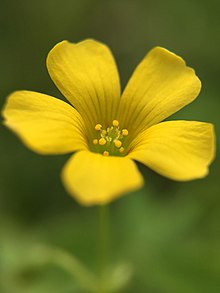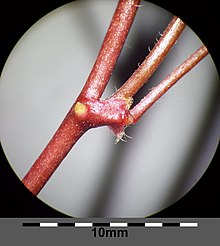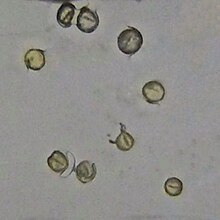| Oxalis corniculata | |
|---|---|

| |
| Scientific classification | |
| Kingdom: | Plantae |
| Clade: | Tracheophytes |
| Clade: | Angiosperms |
| Clade: | Eudicots |
| Clade: | Rosids |
| Order: | Oxalidales |
| Family: | Oxalidaceae |
| Genus: | Oxalis |
| Species: | O. corniculata |
| Binomial name | |
| Oxalis corniculata L. | |
| Synonyms | |
List
| |

Oxalis corniculata, the creeping woodsorrel, procumbent yellow sorrel or sleeping beauty, is a somewhat delicate-appearing, low-growing herbaceous plant in the family Oxalidaceae.
It is a small creeping type of woodsorrel that tends to grow well in moist climates. It resembles the common yellow woodsorrel, Oxalis stricta.
Description



It has a narrow, creeping stem that readily roots at the nodes. The trifoliate leaves are subdivided into three rounded leaflets and resemble a clover in shape. Some varieties have green leaves, while others, like Oxalis corniculata var. atropurpurea, have purple. The leaves have inconspicuous stipules at the base of each petiole. The flowers are small and yellow, with some having round-edged petals and others possessing sharp ends. The flowers close when direct sun is not hitting the plant, hence the name "sleeping beauty". Some specimen can have a single flower while others can have over 20.





The fruit is a narrow, cylindrical capsule, 1–2 cm (0.4–0.8 in) long, and noteworthy for its explosive discharge of the contained seeds, 1 mm (0.04 in) long. Pollen is about 34 microns in diameter.
Distribution
This species probably comes from southeastern Asia. It was first described by Linnaeus in 1753 using specimens from Italy, and it seems to have been introduced to Italy from the east before 1500. It is now cosmopolitan in its distribution and is often regarded as a weed in gardens, agricultural fields, and lawns.
Chloroplast genome
The chloroplast genome sequence is 152,189 bp in size, and contains 131 genes. It includes a pair of 25,387 bp inverted repeats that separate a large 83,427 bp single copy region. The genome suggests that this plant is closely related to O. drummondii.
Uses
The leaves of woodsorrel are edible, and have a tangy taste like lemons. A drink can be made by infusing the leaves in hot water for about 10 minutes, sweetening, and then chilling. The entire plant is rich in vitamin C. Any woodsorrel is safe in low dosages, but if eaten in large quantities over a length of time can inhibit calcium absorption by the body.
As a hyperaccumulator of copper, it can be used for phytoremediation. The 1491 Ming Dynasty text, Precious Secrets of the Realm of the King of Xin, describes how to locate underground copper deposits by extracting trace elements of copper from the plant.
Indigenous peoples of Taiwan frequently grow this plant (known roughly as p-r-səʔ) as a cure for snakebites and scabies.
References
- "Oxalis corniculata L." Plants of the World Online. Board of Trustees of the Royal Botanic Gardens, Kew. 2017. Retrieved 14 October 2020.
- BSBI List 2007 (xls). Botanical Society of Britain and Ireland. Archived from the original (xls) on 2015-06-26. Retrieved 2014-10-17.
- ^ Lubna; Asaf, Sajjad; Jan, Rahmatullah; Khan, Abdul Latif; Lee, In-Jung (2020-07-23). "Complete Chloroplast Genome Characterization of Oxalis Corniculata and Its Comparison with Related Species from Family Oxalidaceae". Plants. 9 (8): 928. doi:10.3390/plants9080928. ISSN 2223-7747. PMC 7464629. PMID 32717796.
- Shanpeng Li, Yun Zhang, Jianlin Liu (1 June 2020). "Seed ejection mechanism in an Oxalis species". Scientific Reports. 10 (1). Nature: 8855. Bibcode:2020NatSR..10.8855L. doi:10.1038/s41598-020-65885-2. PMC 7264325. PMID 32483323.
{{cite journal}}: CS1 maint: multiple names: authors list (link) - ^ Groom, Quentin; Van der Straeten, Jan; Hoste, Ivan (2019-02-13). "The origin of Oxalis corniculata L." PeerJ. 7: e6384. doi:10.7717/peerj.6384. ISSN 2167-8359. PMC 6377598. PMID 30783568.
- von Linné, Carl (1753). Species plantarum. Vol. 1.
{{cite book}}:|website=ignored (help) - Hackney, P. 1992. Stewart & Corry's Flora of the North-east of Ireland. Institute of Irish Studies, Queen's University of Belfast.
- UC Davis IPM
- ^ Lee Allen Peterson, Edible Wild Plants, Houghton Mifflin Company, New York City (1977), p. 104.
- Li, Paul Jen-kuei (July 2022). "Some notes on animals and plants for Proto-Austronesian speakers". Language and Linguistics. 語言暨語言學: 259. doi:10.1075/lali.18.2.04li.
External links
| Taxon identifiers | |
|---|---|
| Oxalis corniculata |
|